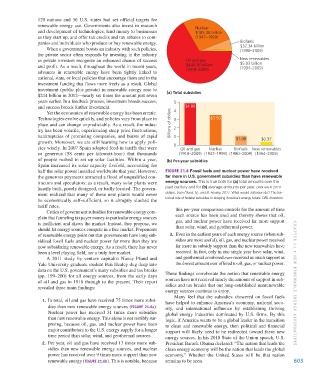Page 604 - Environment: The Science Behind the Stories
P. 604
120 nations and 36 U.S. states had set official targets for
renewable energy use. Governments also invest in research Nuclear
and development of technologies, lend money to businesses $185.38 billion
as they start up, and offer tax credits and tax rebates to com- (1947–1999)
panies and individuals who produce or buy renewable energy. Biofuels
When a government boosts an industry with such policies, $32.34 billion
(1980–2009)
the private sector often responds by investing in the industry
as private investors recognize an enhanced chance of success Oil and gas New renewables
$5.93 billion
and profit. As a result, throughout the world in recent years, $446.96 billion (1994–2009)
advances in renewable energy have been tightly linked to (1918–2009)
national, state, or local policies that encourage them and to the
investment funding that flows more freely as a result. Global
investment (public plus private) in renewable energy rose to (a) Total subsidies
$244 billion in 2012—nearly six times the amount just seven
years earlier. In a feedback process, investment breeds success, 5
and success breeds further investment. $4.86
Yet the economics of renewable energy has been erratic. 4
Technologies evolve quickly, and policies vary from place to 3 $3.50
place and can change unpredictably. As a result, the indus- Billions of dollars
try has been volatile, experiencing steep price fluctuations, 2
bankruptcies of promising companies, and bursts of rapid 1 $1.08 $0.37
growth. Moreover, we are still learning how to apply poli-
cies wisely. In 2007 Spain adopted feed-in tariffs that were 0 Oil and gas Nuclear Biofuels New renewables
so generous (58 cents per kilowatt-hour) that thousands (1918–2009) (1947–1999) (1980–2009) (1994–2009)
of people rushed to set up solar facilities. Within a year, (b) Per-year subsidies
Spain increased its solar capacity fivefold, accounting for
half the solar power installed worldwide that year. However, Figure 21.6 Fossil fuels and nuclear power have received
the generous payments attracted a flood of unqualified con- far more in U.S. government subsidies than have renewable
tractors and speculators; as a result, many solar plants were energy sources. This is true both for (a) total amounts over the
hastily built, poorly designed, or badly located. The govern- past century and for (b) average amounts per year. Data are in 2010
ment realized that many of these new plants would never dollars, from Pfund, N., and B. Healey, 2011. What would Jefferson do? The his-
be economically self-sufficient, so it abruptly slashed the torical role of federal subsidies in shaping America’s energy future. DBL Investors.
tariff rates.
Critics of government subsidies for renewable energy com- this per-year comparison controls for the amount of time
plain that funneling taxpayer money to particular energy sources each source has been used and thereby shows that oil,
is inefficient and skews the market. Instead, they propose, we gas, and nuclear power have received far more support
should let energy sources compete in a free market. Proponents than solar, wind, and geothermal power.
of renewable energy point out that governments have long sub- 3. Even in the earliest years of each energy source (when sub-
sidized fossil fuels and nuclear power far more than they are sidies are most useful), oil, gas, and nuclear power received
now subsidizing renewable energy. As a result, there has never far more in subsidy support than the new renewables have
been a level playing field, nor a truly free market. received. In fact, only in one single year have solar, wind,
A 2011 study by venture capitalist Nancy Pfund and and geothermal combined ever received as much support as
Yale University graduate student Ben Healey dug deep into the lowest amount ever offered to oil, gas, or nuclear power.
data on the U.S. government’s many subsidies and tax breaks
(pp. 199–200) for all energy sources, from the early days These findings corroborate the notion that renewable energy
of oil and gas in 1918 through to the present. Their report sources have not received nearly the amount of support in sub- CHAPTER 21 • N E w R ENE wA bl E E NER gy AlTERN AT iv E s
revealed three main findings: sidies and tax breaks that our long-established nonrenewable
energy sources continue to enjoy.
Many feel that the subsidies showered on fossil fuels
1. In total, oil and gas have received 75 times more subsi- have helped to enhance America’s economy, national secu-
dies than new renewable energy sources (Figure 21.6a). rity, and international influence by establishing thriving
Nuclear power has received 31 times more subsidies global energy industries dominated by U.S. firms. By this
than new renewable energy. This alone is not terribly sur- logic, if America wants to be a global leader in the transition
prising, because oil, gas, and nuclear power have been to clean and renewable energy, then political and financial
major contributors to the U.S. energy supply for a longer support will likely need to be redirected toward these new
time period than solar, wind, and geothermal sources. energy sources. In his 2010 State of the Union speech, U.S.
2. Per year, oil and gas have received 13 times more sub- President Barack Obama declared: “The nation that leads the
sidies than new renewable energy sources, and nuclear clean energy economy will be the nation that leads the global
power has received over 9 times more support than new economy.” Whether the United States will be that nation
renewable energy (Figure 21.6b). This is notable, because remains to be seen. 603
M21_WITH7428_05_SE_C21.indd 603 12/12/14 4:29 PM

